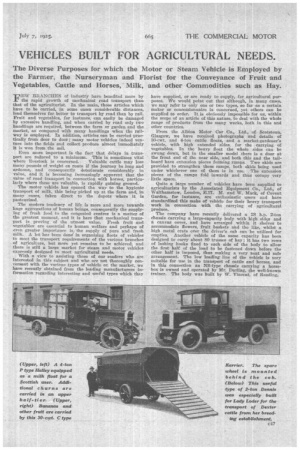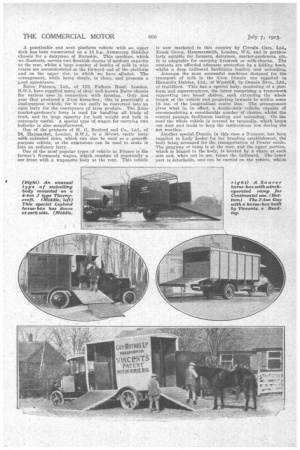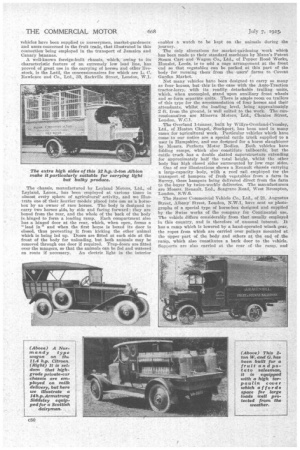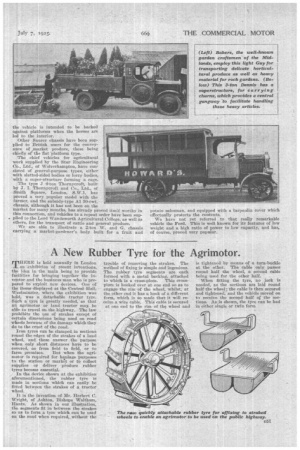VEHICLES BUILT FOR AGRICULTURAL NEEDS.
Page 37

Page 38

Page 39

Page 40

Page 41

If you've noticed an error in this article please click here to report it so we can fix it.
"C1EW BRANCHES of industry have benefited more by
the rapid growth of mechanical road transport than that of the agriculturist. In the main, those articles which have to be carried, in some cases considerable distances, lend themselves far better to transport by road than by rail. Fruit and vegetables, for instance, can easily be damaged by excessive handling, and when carried by road only two handlings are required, between the farm or garden and the market, as compared with many handlings when the railway is employed. In addition, articles can be carried practically from door to door ; many motor vehicles indeed venture into the fields and collect produce almost immediately it is won from the soil.
Even more important is the fact that delays in transport are reduced to a minimum. This is sometimes vital where livestock is concerned. Valuable cattle may lose many pounds of weight en route if the journey be long and arduous, and consequently deteriorate considerably in value, and it is becoming increasingly apparent that the value of road transport in connection with horses, particularly where these are valuable, is rapidly gaining ground.
The motor vehicle has opened the way to the hygienic transport of milk, this being picked up at the farm and, in many cases, taken direct to the depots where it is pasteurized.
The modern tendency of life is more and more towards huge aggregations of human beings, consequently the supplying of fresh food to the congested centres is a matter of the greatest moment, and it is here that mechanical transport is proving of the utmost value. Fresh fruit and vegetables are essential to human welfare and perhaps of even greater importance is the supply of pure and fresh milk. A lot has been donein organizing fleets of vehicles to meet the transport requirements of the various branches of agriculture, but more yet remains to be achieved, and there is still a large market for steam and motor vehicles expressly designed to meet agricultural needs.
With a view to assisting those of our readers who are interested in this subject and who are not thoroughly conversant with the various types of vehicle or. the market, we have recently obtained from the leading manufacturers information regarding interesting and useful types which they have supplied, or are ready to supply, for agricultural purposes. We would point out that although, in many cases, we may refer to only one or two types, so far as a certain maker or concessionnaire is concerned, yet others can be supplied to order. It is obviously imposaible for us, within the scope of an article of this nature, to deal with the whole range of products from the many works, both in this and other countries.
From the Albion Motor Car Co., Ltd., of Scotstoun, Glasgow, we have received photographs and details of 30-cwt. and 4-ton cattle floats, and a market-gardener's vehicle, with high extended sides, for the carrying of vegetables. In the heavy float the whole sides can be swung down, but in the smaller model there is a door at the front end of the near side, and both this and the tailboard have extension pieces forming ramps. Two skids are provided to strengthen these ramps, both skids being used under whichever one of them is in use. The extension pieces of the ramps fold inwards and thus occupy verylittle space.
Quite a large number of vehicles have been supplied to agriculturists by the Associated Equipment Co., Ltd., of Walthamstow, London, E.17. M. and W. Mack, of Covent Garden, for instance, are enthusiastic users and have standardized this make of vehicle for their heavy transport • work in connection with the carrying of agricultural produce.
The company have recently delivered a 28 h.p. 2-ton chassis carrying a large-capacity body with high sides and a canvas cover, and have arranged within it shelves to accommodate flowers, fruit baskets and the like, whilst a high metal crate over the driver's cab can be utilized for empties. Another vehicle of the same capacity has been designed to carry about 80 trusses of hay; it. has two rows of lashing hooks fixed to each side of the body to allow the first half of the load to be fastened down before the other half is imposed, thus making a very neat and safe arrangement. The low loading line of the vehicle is very suitable for use in the transport of cattle and horses, and in this connection an NS-type chassis carrying a horsebox is owned and operated by Mr. Darling, the well-known trainer. The body was built by W. Vincent, of Reading. A practicable and neat platform vehicle with an upper deck has been constructed 411 a14 h.p. Armstrong Siddeley chassis for a dairyman of Burnside, This machine, which we illustrate, carries two Scottish churns of medium capacity at the rear, whilst a largo number Of bottles of milk in wire crates are accommodated at the forward end of the platform and on the upper tier, to which we have alluded. The arrangement, while being simple, is clean, and presents a good appearance.
PalauPatents, Ltd., of 115, Fulham Road, London, 8.W.3, have supplied many of their well-known Baico chassis for various uses in connection with farming. Only last year they produced a 2-ton horse-box; this .1s practically a dual-purpose vehicle, for it can easily be converted into an open lorry for the conveyance of farm produce. The 2-ton market-gardener's lorry is used for handling all kinds of fruit, and its large capacity for both weight and bulk is extremely useful. A special type of wagon for carrying two bullocks is also manufactured.
One of the products of H. G. Burford and Co., Ltd-, of 24, Haynaarket, London, S.W.1, is a. 30-cwt. cattle lorry with extended sides, which can also be used as a generapurpose vehicle, or the extensions can be used to make it into an ordinary lorry.
One of the most popular types of vehicle in France is the farmer's Normandy wagon, which. consists of practically a ear front with a wagonette body at the rear. This vehicle s now marketed in this country by Citron Cars, Ltd., Brook Green, Hammersmith, London, W.6, and is pardonarly suitable for farmers, dairymen, market-gardeners, etc. It is adaptable for carrying livestock or milk-churns. The contents are afforded adequate protection by a folding hood, whilst a drop tailboard facilitates loading and unloading.
Amongst the most successful machines designed for the transport of milk is the 3-ton Dennis van supplied to Howard's Dairies, Ltd., of Westcliff, by Dennis Bros., Ltd., of Guildford. This has a special bedy, consisting of a platorm and superstructure, the latter comprising a framework importing two broad shelves, each extending the whole ength of the vehicle and projecting inwards to within some 8 ins, of the longitudinal centre line.. The arrangement gives what is, in effect, a double-deck vehicle, capable of accommodating a considerable number of churns, whilst the entral passage facilitates loading and unloading. On the mid the whole vehicle is covered by tarpaulin, which keeps out dust and tends to keep the temperature low during the of weather.
Another special Dennis, in this case a 2-tonner, has been implied to Lady Loder for her breeding establishment, the body being arranged for the transportation of Dexter cattle. The gangway or ramp is at the rear, and the upper portion, which is hinged to the body, is located by a chain at each ide and, when not in use, forms the tailboard. The lower iart is detachable, and can he carried on the vehicle, whilst the combined length gives an easy rise. The company also market lorries with high extension sides for market-gardeners, etc., the sides being either slatted or of the metal cage type.
Many of our readers will remember that about a year ago we described in detail the remarkable 6-ton steam wagon manufactured by John Bawler (Leeds), Ltd., of Leeds, this having overhead worm drive, a V-type engine situated under the driver's seat and other features of unusual interest. We learn that this vehicle is being supplied with a special body for the transport of large quantities of milk in churns, and we hope shortly to be able to illustrate it and describe it in more detail. The Fowler wagon is especially suitable for agricultural work, as it has a good clearance for rough roads; also, the loading platform ia exceptionally large compared with the wheelbase, thus allowing bulky loads and easy manceuvring; further, the three speeds afford a low emergency gear for pulling out of difficult situations.
Henry Garner, Ltd., Moseley Works, Birmingham, have :always paid great attention to the needs of the farming community, and amongst their products of this type supply an interesting market-gardener's or farmer's general-purpose vehicle, which forms practically three vehicles in one. First, there is the flat platform lorry, but this carries solid, hinged sides and a tailboard about 18 ins, high, whilst above this can be fitted the crate sides, which are from 3 ft. to 8 ft. 6 ins. high. With these sides it forms a handy vehicle for the carrying of live stack. The chassis is well known, and was fully described in our issue of May 5th.
One of the main features in the Guy vehicle, and one 'which should appeal to the farmer and market-gardener, is the low loading line, obtained by the use of underslung rear springs, and the special design of the frame. The manufacturers are Guy Motors, Ltd., Fallings Park, Wolverhampton, who have sent us a number of pictures of various applications of their chassis. Amongst them is a florist's vehicle built to transport delicate horticultural products from a nursery; this vehicle was photographed while being loaded for. the market, and the detachable aide and end latticed body boards have been removed to facilitate this operation. This Vehicle also carries heavy material for -building rock gardens, and collects large quantities of seeds and fertilizing material. The Guy is also much favoured as a motor horsebox, owing to its excellent spring and low loading line.
In the sphere of heavy transport, we must not forget the
Hanford, built by J. and B. Hall, Ltd., of Dartford. One -s,chide of this make, of which particulars have been sent Lo us, has a low-sided lorry body with extra high but easily detachable cages, which enable huge quantities of market produce to be 'carried.
Another vehicle, designed expressly for the transport of milk in the special churns of medium size, which are so popular in Scotland, has been built by Halleys Industrial Motors, Ltd., of Yoker, Glasgow. The chassis employed is a type P 4-tonner ; the basis is a plain platform, but at the forward end of this is a steel grill construction which enables a pant tier of churns to be carried.
One interesting feature of the Halley vehicle is that it can be supplied with mechanically, operated fitments, such as a special type hoist gear for assisting in the loading and unloading. By carrying a rope from this device over a pulley, say on a building, loads up to one ton can be lifted to any required height. Additional -fitments can be used for driving, by means of belts, auxiliary farm plants, such as saws, chaff-cutters, mills, etc., whilst included in the category of special vehicles are those for carrying long lengths of timber.
The 11-type 21-ton chassis, with its special low loading line, bnilt by Karrier Motors, Ltd., Huddersfield, has proved an exceptionally useful one for employing with a horse-box, as it affords easy entrance and exit for the animals. The horse-box is so arranged that two horses can be carried without the slightest inconvenience. There is a central partition, and after the first horse has been led out this partition is swung over ready for the exit of the second horse. Other vehicles have been supplied to nurserymen, market-gardeners and users concerned in the fruit trade, that illustrated in this conneetion being employed in the transport of Jamaica and Canary bananas. A well-known foreign-built chassis, which, owing to its characteristic feature of an extremely low load line, has proved of great use in the carrying of horses and other livestock, is the Latil, the concesaionnaires for which are L. C. Rawlence and Co., Ltd., -39, Sackville Street, London, W.1.
The chassis, manufactured by Leyland Motors, Ltd., of Leyland, Laims., has been employed at various times in almost every sphere of agricultural' activity, and we illultrate one of their heavier mbdels placed into use as a horsebox by an owner of race horses. The body is designed to carry two horses side, by side and facing forward ; they are }nixed from the rear, and the whole of the back of the body is. hinged to form a loading ramp. Each compartment also has a hinged door at the rear, which, when open, forms a "lead in" and When the first horse is boxed its door is closed, thus preventing it from kicking the other animal which is being led up. Doors are fitted at each side at the front of the body for unloading, but both animals may be removed through one door if required. Trap-doors are fitted over the mangers, so that the animals can be fed and watered
en route if necessary. An electric light in the interior enables a watch to be kept on the animals during the journey. The only alterations for market-gardening work which has been made to their standard machines by Mann's Patent Steam Cartand Wagon Co., Ltd., of Pepper Road Works, Hunslet, Leeds, is to add a cage arrangement at the front end so that vegetables can be packed at this part of the body for running them from the users' farms to •Covent Garden Market.
Not many, vehicles have been designed to carry so many as four-horses, but-this is:the case with the Auto-Traction tractor-lorry, with its readily . detachable trailing units, which, when uncoupled, stand upon. auxiliary front wheels and so form separate units. There is ample room on trailers of this type for the accommodation of four horses and their attendants, whilst. the loading level, being . approximately 2 ft. from the ground, is well suited to the work. The concessionnairos are Minerva Motors, Ltd., Chenies Street, London,. W.C.1. The Overland 1-tanner, built by Willys-Overlaud-Crossley, Ltd., of Heaton Chapel, Stockport, has been used in many cases for agricultural work. Particular vehicles which have come to our notice are a special cattle truck supplied to a user in Hampshire, and one designed for a horse slaughterer by Messrs. Perfecta 'Motor Bodies. Both vehicles have folding ramps, which also constitute tailboards, but the cattle truck has a double slatted superstructure extending for approximately half the total height, whilst the other body -has high closed sides surmounted by low, cage sides.
One of our illustrations shows a Renault chassis carrying a large-capacity body, with a roof •rail employed for the transport, of hampers of fresh vegetables from a farm in Surrey, these hampers being delivered direct from the farm to the buyer by twice-weekly deliveries. The manufacturers are Messrs. Renault, Ltd., Seagrave Road, West Brampton, London, S.W.G.
The Saurer Commercial Vehicle Co., Ltd., of 21, Augustus Street, Albany' Street, London, N.W.1, have sent us photo-. graphs of a special type of horse-box designed and supplied by the Swiss works of the company for Continental use. The vehicle differs considerably from that usually employed iu this country, and is therefore of unusual interest: It has a ramp which is lowered by a hand-operated winch gear, the ropes from which are carried over pulleys mounted at the upper part of the body and others at the enq of the ramp, which also constitutes a back door to the 'vehicle. Supports are also carried at the rear of the ramp; and
the vehicle is intended to be backed against platforms when the horses are led to the interior, Other Saurer chassis have been supplied to British users for the conveyance of ,market produce, these being chiefly of the flat platform. type.
The chief vehicles for agricultural work supplied by the Star Engineering Co., Ltd., of Wolverhampton, have con: slated of general-purpose types, either with slatted-sided bodies or lorry bodies, with a super-structure forming a cage.
The type 34-ton Thornycroft, built by J. I. Thornyeroft and Co., Ltd., of
Smith Square, London, has proved a very popular model with the farmer, and the subsidy-type Al 80-cwt. chassis, although it has not been on the market for inanY months, has already proved itself worthy in this connection, and vehicles to a repeat order have been sup. plied to the Lord Wandsworth Agricultural. College, as well as others, for the transport of cattle and general produce. We are able to illustrate a 2-ton W. and G. chassis carrying a market-gardener's body built for a fruit and potato salesman, and equipped with a tarpaulin cover which effectually protects the contents.
We have not yet referred to that really remarkable vehicle the Ford. This is well known for its features of low weight and a high ratio of power to low capacity, and has, of course, proved very popular.














































